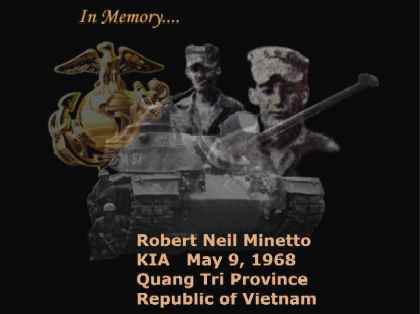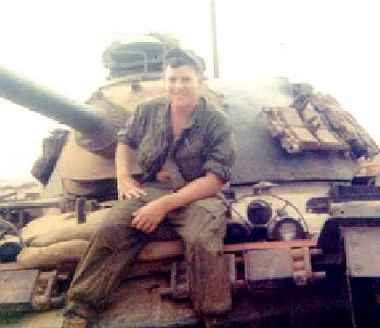|
On May 9, 1968 Robert Neil
Minetto gallantly gave his life in the service of our Country. While
participating in operations with Third Tank Battalion, Third Marine
Division in support of Bravo Company, 1st Battalion, 9th Marines, south
of Gia Lihn in the notorious area known as "Leatherneck Square" in the
Republic of Vietnam.
These are the details of the
incident that took Robert Minetto's life as related by his good friend
John Wear:
Bob Minetto
It was early May in what was to
become the bloodiest year of the Viet Nam War, 1968. A Marine Corps
operation was underway around the thick vegetation covered sand dunes
south of the Gia Lihn firebase in the notorious and deadly area that the
Marines called "Leatherneck Square." This particular operation had three
3rd Tank Battalion, 3rd Marine Division tanks supporting Bravo Company
of the 1st Battalion of the 9th Marine Infantry Regiment (grunts), 3rd
Marine Division plus two platoons of South Vietnamese (ARVN) soldiers
from the ARVN District Headquarters at Gia Linh.
The operation was to be a fairly routine one in that there had not been
much enemy activity reported over the past few weeks in this area,
therefore no major contact was expected. This sweep was also a little
different in that there were two gun tanks plus a flame-thrower tank
accompanying the Marine grunts and the ARVN. Gun tanks with their 90-mm
cannons were almost always involved with supporting Marine infantry,
however flame-thrower tanks usually were only deployed during major
operations when well-entrenched enemy troops were hold up in reinforced
bunkers and where they had to be burned out. The plans for this
particular operation did not include any enemy bunker complexes
therefore the flame tank's worth could be questioned.
The two gun tanks were from Alfa Company and the flame tank was from H&S
Company. These tankers had worked with one another before and knew the
ropes. The three tanks were abreast of each other (on line) and spaced
about fifty yards apart as they approached the crest of a wide horseshoe
shaped hill. Corporal Bob Minetto (Reno, NV) was the tank commander of
the gun tank on the right side of the sweeping force. The middle tank,
also a gun tank, was commanded by Corporal John Perry (Florescent, MO).
The tank on the left flank was the flame-thrower tank, commanded by
Corporal Frank Eaton (Flint, MI). They were on line (with the grunts
between and behind them) as they slowly approached the top of the
crescent-shaped hill when all hell broke loose. Three North Vietnamese
Army (NVA) .51-caliber heavy machine guns and an estimated thirty to
forty Chicom (Chinese Communist-built) AK-47 automatic rifles opened up
on the exposed Marines.
The gun tanks immediately took the enemy machine guns under fire with
cannister and HE (high explosive) rounds from their main guns. It seemed
that they were having little effect on the well dug-in enemy who as it
turns out were in reinforced bunkers. The withering heavy machine gun
fire kept up its murderous pace. A call came over the radios for Cpl.
Eaton to pull his flame-thrower tank forward and to burn the enemy off
the hill. Cpl. Eaton pulled his tank forward fairly quickly but then the
tank did a quick reverse, backing behind the grunt lines. As it turned
out later, when Cpl. Eaton's gunner went to charge the main bottle with
compressed air (to enable the tank to shoot its napalm load) the poorly
designed safety system blew the safety valve. When the safety valve
blew, the tank lost 100% of the compressed air thus making the
flame-thrower 100% useless. If this accident had not happened, the enemy
soldiers would have been "crispy critters" in short work.
Meanwhile, the two gun tank commanders realized that they were so close
to the enemy positions that they could not get a clear shot and had no
clear field of fire for their main weapons. The Marine grunts were
helplessly pinned down and completely reliant on the tanks to suppress
the enemy fire. The tanks were slowly approaching the enemy line but the
enemy fire was increasing.
I will use Cpl. Perry's own assessment of the situation. "The gooks
waited until we were practically on top of them before they opened up on
us. Our tanks were too close to their position to have effective main
gun or machine gun fire. I looked over towards Minetto's tank. I saw
that there were NVA troops running toward the rear of the tank and it
appeared as if they were trying to throw grenades or satchel charges
inside. I saw Bob stick his head out of the cupola, toss out two or
three hand grenades and then shoot at least three gooks with his .45
(pistol). He then ducked down inside the tank. I called over to him on
the radio and told him that I would 'scratch his back' with my machine
gun (shoot the enemy soldiers off of the tank) but that he'd better
'button up' (close the access hatches of the tank). I got no response
from Bob's tank."
Evidently what had taken place was that as Cpl. Minetto realized that
there was no clear or effective way to shoot the main 90-mm cannon to
stop the enemy's ambush. The tank's gunner was busy shooting the tank's
coaxial .30-caliber machine gun so Cpl. Minetto must have decided to use
his .45-caliber semi-automatic pistol to shoot the attacking enemy
soldiers. As Cpl. Perry described, there were NVA soldiers who had
actually tried to climb on to the tank and throw satchel charges or hand
grenades inside the tank (through the TC's and loader's hatch) to kill
the Marine tankers inside. Cpl. Minetto exposed himself to the intense
enemy fire, threw two of his own fragmentation grenades and then emptied
his side arm at the enemy soldiers killing at least the three that Cpl.
Perry saw him hit. According to the tank's loader, Cpl. Minetto then
reached inside and called for the loader to give him his loaded pistol.
At that exact same moment, as Cpl. Minetto was bravely saving his tank
and crew from being overrun, he was mortally shot through the neck and
was instantly killed. As he fell back inside the tank the loader and the
gunner panicked. A distress call to Cpl. Perry came over the tank radio
from Minetto's driver that said that Cpl. Minetto was shot and that the
gunner was unable not take command of the tank. He said that all hell
was breaking loose! Cpl. Perry acknowledged the situation and called
over for the loader to button up the turret, which he complied to
quickly. Cpl. Perry had his own tank's gunner "scratch the back" of
Minetto's tank by turning his own .30-caliber machine gun on to
Minetto's tank thus shooting the attacking NVA soldiers off of the other
tank. Since Cpl. Minetto's tank was virtually on top of the NVA machine
gun bunkers, Cpl. Perry had Minetto's tank driver pull the tank forward.
As the 52-ton tank moved up, Perry had the tank do a "neutral steer" on
top of the bunker thus crushing the heavy-machine gun bunker and the
enemy soldiers inside. As Perry was having Minetto's tank perform this
maneuver, he had his own driver do the same to the bunker in front of
his tank. The trick worked! Two of the enemy's heavy machine guns were
silenced. The enemy's automatic weapons fire was suppressed enough to
allow the Marine grunts to get up and attack the remaining enemy. In
just a few minutes the enemy soldiers had all been either killed or
taken prisoner. The result of this brutal ambush was that there were far
too many Marine and ARVN casualties. The withering machine gun fire of
this ambush had decimated the entire Marine Company, both ARVN platoons
and one Marine tank commander. It was so intense that there were not
enough unwounded Marines to make a complete infantry platoon (which
would normally be 44 men).
Upon inspecting the enemy positions after the firefight, the grunts
found many small bags containing a white powder in the backpacks of the
NVA soldiers. Was this opium? The enemy soldiers had US military
communications wire tied around the joints of their legs and their arms
apparently to act as tourniquets (to stanch bleeding) if they were to
get hit during the ambush. It was also discovered that the NVA machine
gunners were tied to the machineguns so that they could not run away if
they were over ran by the Marines.
The United States Marine Corps lost a brave Marine and I lost a close
friend with the death of Robert Neil Minetto. I miss him to this very
day. I am often in Washington, D.C. on business or for personal reasons.
When I am there, I always visit Bob's name on The Wall (the Vietnam
Veterans Memorial). I always touch the etching in the black polished
marble and I say a prayer for Bob. I always tell him that he did not die
in vain. And I tell him that there are many people out here that
remember him, who miss him and who wish he was here with us. Semper
Fidelis, Marine! |

